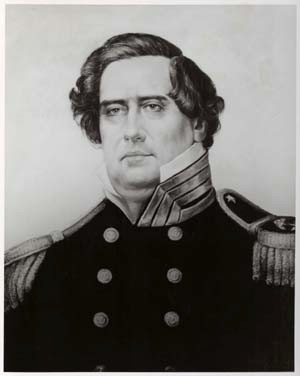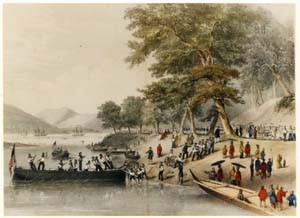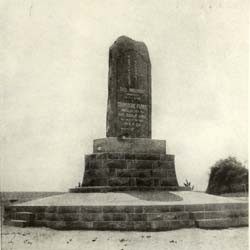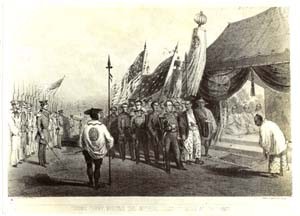Chronology of Service
Ships On Which Perry Served
Matthew Calbraith Perry was born in Newport, Rhode Island, on 10 April 1794, son of Captain Christopher R. Perry, a distinguished officer of the Revolutionary War, and Sarah Wallace (Alexander) Perry. In 1814 he was married to Jan Sliddell, and they had ten children. He died in New York City, on 4 March 1858, and was interred in the vaults of the Church of St. Mark's-in-the-Bouwerie in New York. On 21 March 1866, the bodies of Commodore Perry and his child, Anna who died in 1839, were reinterred in Newport, Rhode Island.
Appointed Midshipman in 1809, he first saw service under his brother, Oliver Hazard Perry, in the Revenge. During the War of 1812, he served in squadrons commanded by Commodores Rodgers and Decatur and was promoted to Lieutenant in 1813. He made several cruises to the coast of Africa and to the Mediterranean, and commanded the schooner Shark in the West Indies. He was promoted to master commandant in 1826 and named a captain eleven years later. From 1838 to 1840 he commanded the steam frigate Fulton in connection with experiments in steam navigation.
Sailors unload boat howitzers for escort duty in Japan with Commodore Matthew C. Perry, U.S. special envoy and commander in chief of naval forces in the East Indian seas. This view appears on the front endpapers to John A. Dahlgren's Boat Armament of the U.S. Navy, 1856 edition.
In 1844 he went to the coast of Africa as Commodore of the squadron assigned to those waters. During the Mexican War, he joined the Home Squadron in the Gulf of Mexico in 1846, and conducted several expeditions against the towns of Tobasco and Laguna. In March 1847 he succeeded Commodore Connor in command of the squadron, which was then engaged in besieging Vera Cruz. After the war he was ordered home on special duty, 1849-1852, after which he sailed for the East Indies on a cruise which became memorable in the annals of the U.S. Navy, and during which he carried the American flag into Japanese waters, and concluded a treaty which opened their ports to American enterprise.
His success in establishing good relations with Japan can be attributed to his combining diplomacy with dignity and a bold display of impressive force. On 8 July 1853, he unexpectedly appeared in Tokyo Bay with two steam frigates and two sloops-of-war. He declined to deal with minor officials, flatly refused to obey directions to go to Nagasaki (where the Dutch had a trading post), dispersed the swarms of guard-boats surrounding the squadron by threatening the use of force, and deliberately disregarded a prohibition against taking soundings. He insisted upon presenting to a high official on shore, a letter from President Fillmore addressed to the Japanese Emperor. This was reluctantly agreed to by uneasy Japanese. On 14 July the steam frigates Susquehanna and Mississippi moved close to the shore and landed 400 seamen and marines. The Commodore followed with special attendants, proceeded with much pomp to the council house and presented his documents very formally to the Princes Iduzu and Iwami. They gave a receipt.
Three days later Perry sailed away leaving word that he would return for an answer. After seven months he entered the bay again, and with a much more powerful squadron. His reception was most cordial, gifts and entertainments were exchanged, and the treaty was negotiated, opening two ports to American commerce.
Commodore Perry returned to Washington and was on special duty in the Navy Department for several years, connected with his expedition to Japan.
USS Commodore Perry, a side-wheel steamer purchased in 1861, was named in honor Commodore Matthew Calbraith Perry and his brother Commodore Oliver Hazard Perry. Three other warships were named Perry in honor of both men; DD-844 was the last, the others being DD-11 (a pre-WWI destroyer) and DMS-17 (a minesweeper converted from the destroyer DD-340). Two other warships were named solely for Commodore Oliver Hazard Perry, a brig commissioned in 1843 and FFG-7.
Source: "Commodore Matthew C. Perry, U.S. Navy, Deceased," produced by Navy Office of Information, Internal Relations Division, 18 November 1963, located in Matthew C. Perry ZB file, box 176, Navy Department Library.
Ships On Which Perry Served
US schooner Revenge Mar. - Oct. 1809
US frigate President Oct. 1810 - Nov. 1813
US frigate United States Nov. 1813 - Apr. 1814
US frigate President Apr. - Dec. 1814
US brig Chippewa, Mediterranean Squadron Jan. - Nov. 1815
USS Cyane, West Coast of Africa Aug. 1819 - Mar. 1821
US schooner Shark West India Squadron May 1821 - Sep. 1823
Receiving ship Fulton, N.Y., Comdg. Sep. 1823 - Sep. 1824
USS North Carolina, Executive Officer,
Mediterranean Squadron Sep.1824 - Aug. 1827
USS Concord, Comdg., Mediterranean Squadron Apr. 1830 - Dec. 1832
US steamer Fulton, Comdg. Aug. 1837 - Jun. 1838
US steamer Fulton, Comdg. Feb. 1839 - Mar.1840
US frigate Macedonian, Comdg.,
Flagship, African Squadron Jul. 1843 - Apr. 1844
USS Mississippi, first as Comdg. Officer,
later Comdg. Home Squadron Oct. 1846 - Sep. 1847
USS Mississippi, Comdg. East India Squadron May 1852 - Apr. 1855
Promotions and Dates of Same
Midshipman 16 Jan. 1809
Lieutenant 24 Jul. 1813
Commander 21 Mar. 1826
Captain 9 Feb. 1837
Source: "Ships on Which Perry Served." Unpublished letter from F.E. Sharswood, to Mr. Samuel Wood Bryant, Jr., dated 24 Dec. 1952, serial number Op-296/fes, located in Matthew C. Perry ZB file, box 176, Navy Department Library.
Chronology of Service
1794
10 Apr. - Born, fourth child of Christopher Raymond Perry and Sarah Wallace(Alexander) at Newport, R. I.
Perry was a member of a naval family. His father, Christopher Raymond Perry, served in the Continental and U.S. Navies. Perry and his four brothers, including Oliver Hazard Perry of Lake Erie fame, were naval officers and two of his three sisters married naval officers.
1809
16 Jan. - Date of warrant as Midshipman.
11 Mar. - Acceptance and oath forwarded from Newport, R. I.
Mar. - First active service was on the 12-gun Schooner U.S.S. Revenge commanded by his brother, Lieutenant Oliver Hazard Perry.
12 Oct. 1810 - 12 Nov. 1813 - Ordered by the Secretary of the Navy to "repair to New York" and place himself under the Commanding Officer of the U.S.S. President, Commodore John Rodgers, a strict disciplinarian, who impressed many of his qualities upon the young naval officer. Participated in the action with H.B.M.S. Little Belt and in the chase of the British Frigate Belevidere, in which action he was wounded. Served during the cruise of the U.S.S. President in the Atlantic Ocean against British commerce.
1813
24 Jul. - Promoted to Lieutenant.
Nov. 1813 - Apr.1814 - Attached to the U.S. Frigate United States. Commanded by Commodore Stephen Decatur. The ship was driven into New London and remain blockaded there until the conclusion of peace.
1814
Apr. - Dec. - Served on board the U.S.S. President, which at this time was being used in the defense of New York City.
1815
Jan. - Nov. - Attached to U.S. brig Chippewa, commanded by Lt. George C. Reed, one of the ships in the Mediterranean squadron under Commodore Bainbridge. This squadron was one of two organized after the declaration of war on Algiers. Sailed from Boston 5 Jul. 1815. Arriving at Carthagena, Bainbridge learned that peace had been concluded with Algiers. He had orders to show his squadron at various Barbary ports. Appearance of this second powerful squadron had a very salutary effect on the Barbary Powers.
7 Jan. 1816 - Sep. 1817 - On furlough from the Navy. Made a voyage to Holland as Master of a merchant ship.
1817
22 Sep. - Ordered to Navy Yard, New York.
1819
5 Aug. - Detached.
5 Aug. 1819 - Mar. 1821 - Served as Executive Officer, U.S. sloop Cyane when that vessel conveyed the S.S. Elizabeth carrying the first colony of Negroes from the United States to the west coast of Africa.
8 Jun. 1821 - 11 Aug. 1825 - Commanding Officer, U.S.S. Shark, transporting the U.S. agent to the colony later named Liberia. In February 1822 took active part in extirpating piracy and slave trade in the West Indies. Made another trip to Africa in 1822 and one to Mexico in 1823.
1823
29 Jul. - Ordered to the receiving ship U.S.S. Fulton at New York.
Sep. 1824 - 5 Aug. 1827 - Served as Executive Officer, U.S.S. North Carolina, flagship of the Mediterranean Squadron under Commodore Rodgers, engaged in protesting American commerce from Greek pirates. In 1825-26 participated in a visit to the headquarters of the Greek Revolutionists and in an interview with the Captain Pasha of the Turkish Fleet. Promoted to Master Commandant, 21 Mar. 1826.
1827
17 Aug. - Ordered to command the Naval Rendezvous at Boston.
1830
21 Apr. - Detached.
22 Apr. 1820 - 10 Dec. 1832 - Ordered to take command of the U.S. sloop Concord, which vessel was assigned to transport John Randolph of Roanoke, Va., as envoy to the Czar of Russia. Granted private audience with Czar Nicholas of Russia at St. Petersburg, who invited him to enter the Russian Navy, which offer he declined. Joined the Squadron in the Mediterranean in July 1832. Due to Commodore Biddle's poor health, temporarily was in command of the U.S.S. Brandywine, participating in the naval demonstration made at Naples for the purpose of compelling payment of spoliation claims.
7 Jan. 1833 - 15 Mar. 1837 - Ordered to report to Navy Yard, New York, where he was second in command. At this time became a resident of New York City thereafter making that city his home.
Much interested in naval education and in 1834 had drawn up plans for naval apprentice system. Continued agitation until it was established by Congress in 1837.
In 1833 took the lead in organizing at the New York Navy Yard, the U.S. Naval Lyceum, to promote the diffusion of knowledge among naval officers. He was its first curator, in 1836 its vice-president, and later its president.
Assisted in founding and contributing liberally to the Naval Magazine, the first American periodical under the supervision of naval officers.
Member of the committee that advised the Secretary of the Navy with regard to the scientific work of the U.S. Exploring Expedition, of which he was offered the command, and which he refused.
Member of the board of examiners that in 1845 prepared the first course of instruction for the Naval Academy.
1837
9 Feb. - Promoted to a captaincy.
His interest in the revolution of naval material beginning in 1830's exceeded that of any other officer. He was an early advocate of the steam navy. Sometimes called the Father of the Steam Navy.
Aug. 1837 - Jun. 1838 - Commanded the first steam war vessel of our Navy, the U.S.S. Fulton, at which time he organized the first Naval Engineer Corps.
Member of a naval board appointed to study the water approaches to New York. Report made by him in 1837 (Senate Doc. No. 375, 25th Cong., 2nd Sess.) was used in Congress in behalf of legislation creating lighthouses.
In 1838 was sent to England and France to examine lighthouses of these countries and to collect information on use and construction of naval steamships and ordnance.
1839 - 40 - Conducted at Sandy Hook and on board the Fulton, the first American school of gun practice.
Established at Sandy Hook an experimental battery for testing guns, shells and shot. One of his reports to the [Navy] Department dealt with the use of naval steamships as rams.
1841
12 Jun. - Appointed Commandant of the Navy Yard, New York, serving the department as technical expert on steamships and naval inventions.
20 Feb. 1842 - May 1845 - Ordered to hold himself in readiness to take command of the African Squadron (flagship U.S.S. Saratoga) which was organized that year to aid in the suppression of the slave trade and also to protect the settlements of American Negroes in Africa. Detached 1 May 1845 and granted leave.
Dec. 1845 - May 1846 - Ordered to examine merchant steamers and decks in New York. Examination completed 4 Feb. 1846. Made another examination of steamers at New York, 18 May 1846.
1846
20 Aug. - Ordered to command the U.S.S. Mississippi. During the early part of the Mexican War, he served under Commodore Connor but upon Connor's recall in 1847, Perry succeeded him as Commander of the Home Squadron, operating on the east coast of Mexico.
In the latter part of 1846 he commanded the expedition that captured Frontera, Tabasco and Laguna.
1847
21 Mar. - 29 Mar. - Commanded the naval forces and shared with General Winfield Scott the credit for the capitulation of the city on 27 Mar.
Later captured Tuxpan and other fortified forts. He demanded and received from Yucatan a promise of neutrality.
1848
20 Nov. - Detached from Command of the Home Squadron and ordered to be the General Superintendent of Ocean Mail Steamers.
1849
3 Nov. - Ordered to report to the Navy Department.
1852
3 Mar. - 24 Mar. - Detached as Superintendent of Ocean Mail Steamers. Ordered to command the East India Squadron.
1852
13 May - Again placed in command of the U.S.S. Mississippi. During the summer of 1852 as a brief interlude in his preparation for the expedition to Japan, he was sent to the British provinces to adjust some differences concerning the rights of American fishing vessels. Assisted in bringing about the reciprocity treaty.
The preceding January (1852) he had been selected by President Fillmore to undertake the diplomatic mission of negotiating a treaty with Japan, which up to that time had no contact with the occidental powers. Instructions from the State Department stipulated that the objects of the expedition were the protection of American seamen and property in Japan and Japanese waters and the opening of one or more ports to American vessels for the procuring of supplies and for conducting trade. Perry was directed to first try persuasion and argument and in case of failure, he was to resort to stronger tactics but keeping in mind that the mission was one of peace.
1852
24 Nov. - Sailed from Norfolk for China on board the U.S.S. Mississippi.
1853
May - After assembling his fleet at Napa, Great Lu-Chu Island, sailed to Yedo, capital of Japan, with U.S.S. Susquehanna as flagship, in company with the Saratoga, Mississippi and Plymouth, arriving at the capital on 8 Jul. 1853.
Commodore Matthew C. Perry, USN, landed at Yokohama, Japan on 8 March 1854 with 500 men amid pomp and ceremony and received the answer to President Fillmore's letter which he had personally delivered.
1853
14 Jul. - Delivered to the representatives of the Emperor the letter addressed to the ruler of Japan, which declared the nature of Perry's mission. In order to allow time for reflection and discussion, Perry sailed to China after informing the representatives of the Emperor that he would return the following year.
1854
Feb. - Returned to Japan and on 31 Mar. 1854, he was successful in having signed the treaty of peace, amity and commerce, granting the United States trading rights at the ports of Hakodate and Shimoda, thus inaugurating a new era in the history of Japan [Treaty of Kanagawa].
1854
Sep.- Sailed for home on British steamer Hindostan from Hong Kong, arriving in New York 12 Jan. 1855.
1856
20 Jun. - Ordered to Washington as a member of the Efficiency Board under the act of Congress, 28 Feb. 1855, but his chief duty was the preparation of a report of expedition, which was published by the government in 1856 in three volumes under the title of Narrative of the Expedition of an American Squadron to the China Seas and Japan, Performed in the Years 1852, 1853, and 1854, Under the Command of Commodore M.C. Perry, United States Navy, [3 vols. Washington, DC: A.O.P. Nicholson, 1856].
1858
4 Mar. - Died in New York City.
Source: "Matthew Calbraith Perry." Unpublished typescript, dated 13 Mar. 1953, located in Matthew C. Perry ZB file, box 176, Navy Department Library








